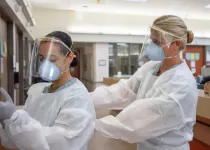(Press-News.org) CLEVELAND - Evidence suggests particulate matter is the air pollutant which poses the greatest threat to global health. Studies have shown that exposure to particulate matter smaller than 2.5 microns is associated with acute and chronic elevations in blood pressure (BP) as well as hypertension. In the study "The Benefits of Intensive Versus Standard Blood Pressure Treatment According to Fine Particulate Matter Air Pollution Exposure" published this week in the journal Hypertension, researchers at University Hospitals (UH) and Case Western Reserve University (CWRU) School of Medicine found intensive BP lowering is effective in reducing cardiovascular risk in patients exposed to high levels of air pollution.
Air pollution, particularly fine particulate matter, has been implicated in cardiovascular risk, partly through effects on BP. Particulate matter smaller than 2.5 microns is concentrated particles that develop from human impact on the environment, such as automobile exhaust, power generation and other fossil fuels. Researchers sought to determine if intensive BP lowering on cardiovascular events is modified by air pollution exposure in the NIH-funded Systolic BP Intervention (SPRINT) Trial.
Researchers linked integrated satellite-derived air pollution exposures with residential addresses for 9,286 patients enrolled in the SPRINT trial. The study showed that intensive BP lowering (defined as goal systolic blood pressure lower than 120 mmHg) led to significant reduction in cardiovascular events (combination of heart attack, strokes, heart failure, or death from cardiovascular disease) especially in patients exposed to higher pollution levels. The authors concluded that ambient air pollution may influence the benefit of intensive BP lowering. Lowering BP is particularly beneficial for patients who are exposed to high levels of fine particulate matter and it may even reduce adverse cardiovascular effects of particulate matter pollution.
"Air pollution impacts socioeconomically disadvantaged patients to a higher degree. Living within a particular neighborhood should not mean you are more likely to suffer from cardiovascular disease," said Sadeer Al-Kindi, MD, cardiologist with UH Harrington Heart & Vascular Institute, Assistant Professor, CWRU School of Medicine and the lead author of the study. "University Hospitals has a history of addressing health care disparities in underserved communities and armed with the information from this study, we can thoughtfully create solutions to better serve these populations."
Patients exposed to high levels of air pollution can take control of their health in knowing that lowering their BP is effective in reducing cardiovascular risk.
"This study improves our understanding of the intersection between air pollution, heart disease and blood pressure. It also has implications in management of patients who are exposed to high levels of air pollution," said Sanjay Rajagopalan, MD, Chief of Cardiovascular Medicine, UH Harrington Heart & Vascular Institute, Professor, CWRU School of Medicine and the senior author of the study.
"This is one of the few findings from SPRINT showing potential heterogeneity in the benefit of BP lowering on cardiovascular outcomes," said Jackson Wright, MD, PhD, a member of the SPRINT Steering Committee, Director, Clinical Hypertension Program, UH Cleveland Medical Center and Professor Emeritus, CWRU School of Medicine. "The findings of this novel analysis of the SPRINT trial may provide additional insight and avenues of further investigation into the harmful impact of air pollution on cardiovascular disease."
"Next steps in this research involve studying the mechanistic underpinnings of this effect modification and identifying methods to reduce pollution exposure and reduce the harmful effects of air pollution on the cardiovascular system," said Dr. Al-Kindi.
INFORMATION:
About University Hospitals / Cleveland, Ohio
Founded in 1866, University Hospitals serves the needs of patients through an integrated network of 19 hospitals (including 4 joint ventures), more than 50 health centers and outpatient facilities, and 200 physician offices in 16 counties throughout northern Ohio. The system's flagship academic medical center, University Hospitals Cleveland Medical Center, located in Cleveland's University Circle, is affiliated with Case Western Reserve University School of Medicine. The main campus also includes University Hospitals Rainbow Babies & Children's Hospital, ranked among the top children's hospitals in the nation; University Hospitals MacDonald Women's Hospital, Ohio's only hospital for women; University Hospitals Harrington Heart & Vascular Institute, a high-volume national referral center for complex cardiovascular procedures; and University Hospitals Seidman Cancer Center, part of the NCI-designated Case Comprehensive Cancer Center. UH is home to some of the most prestigious clinical and research programs in the nation, including cancer, pediatrics, women's health, orthopedics, radiology, neuroscience, cardiology and cardiovascular surgery, digestive health, transplantation and urology. UH Cleveland Medical Center is perennially among the highest performers in national ranking surveys, including "America's Best Hospitals" from U.S. News & World Report. UH is also home to Harrington Discovery Institute, part of The Harrington Project for Discovery & Development. UH is one of the largest employers in Northeast Ohio with 28,000 physicians and employees. Advancing the Science of Health and the Art of Compassion is UH's vision for benefitting its patients into the future, and the organization's unwavering mission is To Heal. To Teach. To Discover. Follow UH on LinkedIn, Facebook @UniversityHospitals and Twitter @UHhospitals. For more information, visit UHhospitals.org.
A paper by a multidisciplinary team of scientists affiliated with various Brazilian institutions, including the University of São Paulo (USP) and the National Cancer Institute (INCA), shows that people of African descent are less likely to find a donor in the National Register of Voluntary Bone Marrow Donors (REDOME) than people with predominantly European ancestry. The paper is published in Frontiers in Immunology.
REDOME is the world’s third-largest bone marrow bank, with more than 5 million registered voluntary donors.
According to the study, having mainly African genetic ancestry can reduce a person’s chances of finding a donor by up to 60%, and having African copies of HLA genes, which must be compatible with ...
Obesity and its duration are significant risk factors for type 2 diabetes, cardiovascular events, multiple cancers and decreased quality of life. According to the Centers for Disease Control and Prevention, obesity affects 20.6% of adolescents ages 12-19 in the United States, meaning a potential lifetime of dealing with this condition. Complications from obesity can also result in a potentially decreased life expectancy of five to 20 years for these youth. In a new study published in Pediatrics, researchers at Children's Hospital Colorado (Children's Colorado) have found that both younger and older adolescents have similar weight loss, resolution of high blood pressure and high cholesterol, nutritional impacts and improvement in quality of life after bariatric surgery. These results ...
Article Title: "Game theory to enhance stock management of Personal Protective Equipment (PPE) during the COVID-19 outbreak"
Funding: The authors received no specific funding for this work.
Competing Interests: The authors have declared that no competing interests exist.
Article URL: https://journals.plos.org/plosone/article?id=10.1371/journal.pone.0246110
INFORMATION: ...
Decoy protein intercepts spike of coronavirus
Virus prevented from infecting human cells
Protein may be new way to treat and prevent COVID-19
CHICAGO --- Northwestern Medicine scientists have developed a new protein that acts as a trickster to neutralize the COVID-19 infection in a human kidney organoid, a miniature organ made from stem cells in the lab.
The protein is a variant of ACE2 (angiotensin converting enzyme-2), the receptor the coronavirus uses to enter and infect human cells. The modified protein intercepts the S spike of the coronavirus and fools it into binding to it rather than the real ACE2 receptor in cell membranes. ...
NEW YORK, NY (Feb. 1, 2021)--Errors in the way chromosomes are packed into antibody-producing B cells appear to play a role in the development of B cell-related blood cancers, according to a new study by researchers at Columbia University Vagelos College of Physicians and Surgeons.
The findings could lead to new biomarkers for predicting the onset of these cancers and to a new class of cancer therapies that prevent or correct harmful changes in genome architecture.
The study was published online Feb. 1 in the journal Nature Genetics.
Antibodies are made by immune cells called ...
Taking a particular type of medication to treat enlarged prostate is associated with a reduced risk of developing Parkinson's disease, according to a large observational study led by researchers at the University of Iowa, with colleagues in Denmark and China.
The findings, published Feb. 1 in JAMA Neurology, provide compelling evidence that terazosin, and similar medications, might have the potential to prevent or delay the development of Parkinson's disease.
The new study used data on almost 300,000 older men from two large, independent patient datasets--the Truven ...
A new kind of wearable health device would deliver real-time medical data to those with eye or mouth diseases, according to Huanyu 'Larry' Cheng, Dorothy Quiggle Career Development Professor in the Penn State Department of Engineering Science and Mechanics (ESM).
Cheng recently published a paper in Microsystems & Nanoengineering on new micro- and nano-device technology that could revolutionize how certain health conditions are monitored and treated.
"We sought to create a device that collects both small and large substances of biofluids such as tears and saliva, which can be analyzed for certain conditions on a rapid, continuous basis, rather than waiting on test results from samples in a lab," he said.
The sensors would be placed near the tear duct or mouth to collect samples, ...
Winter survival of honey bee colonies is strongly influenced by summer temperatures and precipitation in the prior year, according to Penn State researchers, who said their findings suggest that honey bees have a "goldilocks" preferred range of summer conditions outside of which their probability of surviving the winter falls.
The results of this study, which used several years of survey data provided by the Pennsylvania State Beekeeper's Association and its members, enabled the development of a tool for forecasting honey bee winter survival to support beekeepers' management decisions, the researchers said.
Honey bees contribute more than $20 billion in pollination services to agriculture in the United States and generate another ...
Toxin-antitoxin (TA) systems are now known to negatively control plasmid replication, according to Thomas Wood, Biotechnology Endowed Chair and professor of chemical engineering in the Penn State College of Engineering.
Plasmids, or extra-chromosomal bits of DNA, allow bacteria to evade antibiotics, making the antibiotics ineffective in halting a bacterial infection.
The presence or absence of plasmids impacts a bacterium's resistance to antibiotics and its ability to cause infection -- important points related to fighting bacterial infections, according to Wood.
"Each year, there are at least 700,000 deaths worldwide because of bacterial infections, a growing number that is projected to increase to 10 million by 2050," Wood said. "And of course, the effectiveness ...
February 1, 2021 - Extracorporeal cardiopulmonary resuscitation (ECPR) is a potentially lifesaving treatment for patients in cardiac arrest when the circulation can't be restored by conventional CPR. New guidelines for ECPR in adults and children, developed by the Extracorporeal Life Support Organization (ELSO), are presented by the ASAIO Journal, official journal of the American Society for Artificial Internal Organs. The journal is published in the Lippincott portfolio by Wolters Kluwer.
A specialized application of extracorporeal membrane oxygenation (ECMO), ECPR is increasingly being used to provide a chance ...



